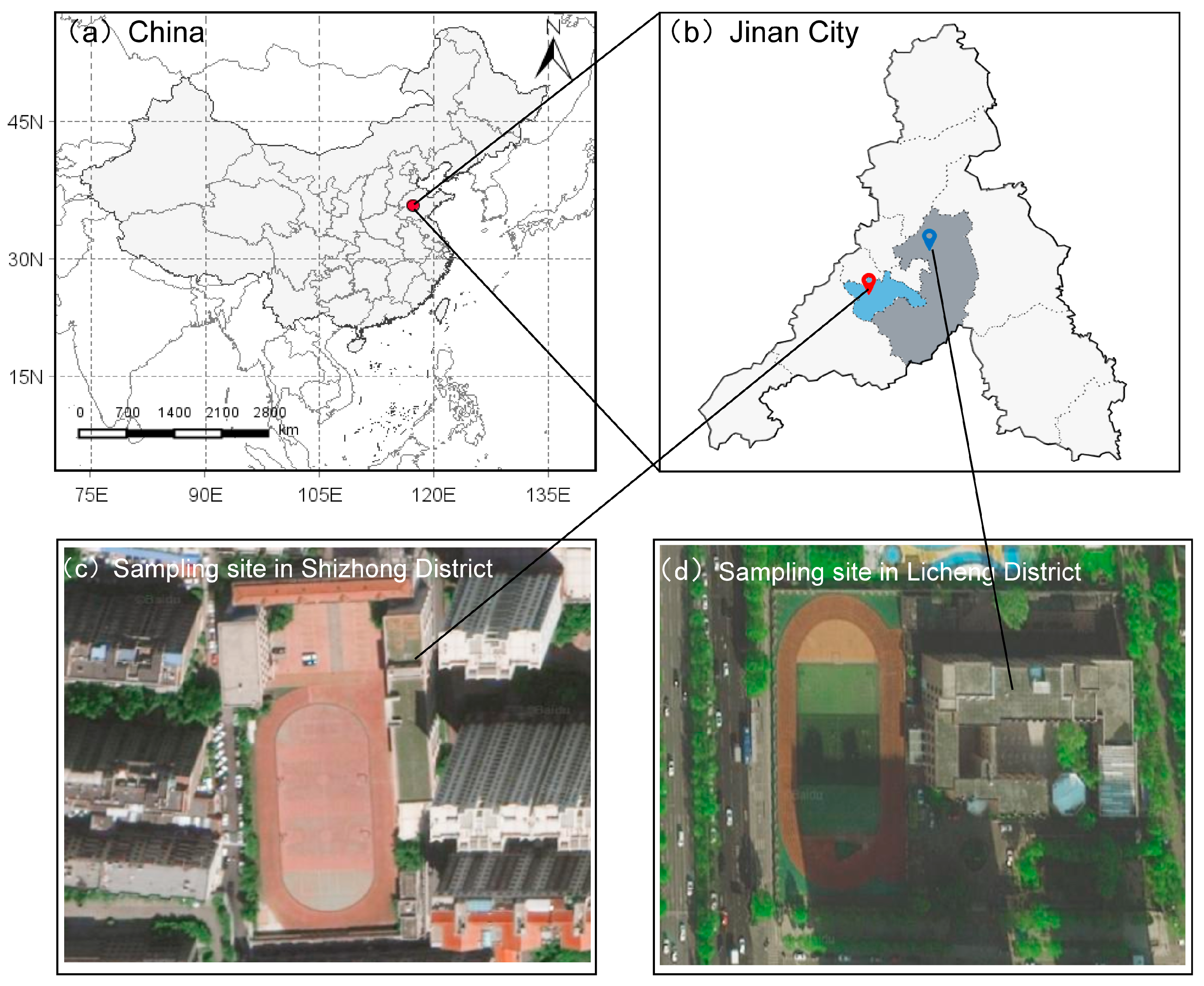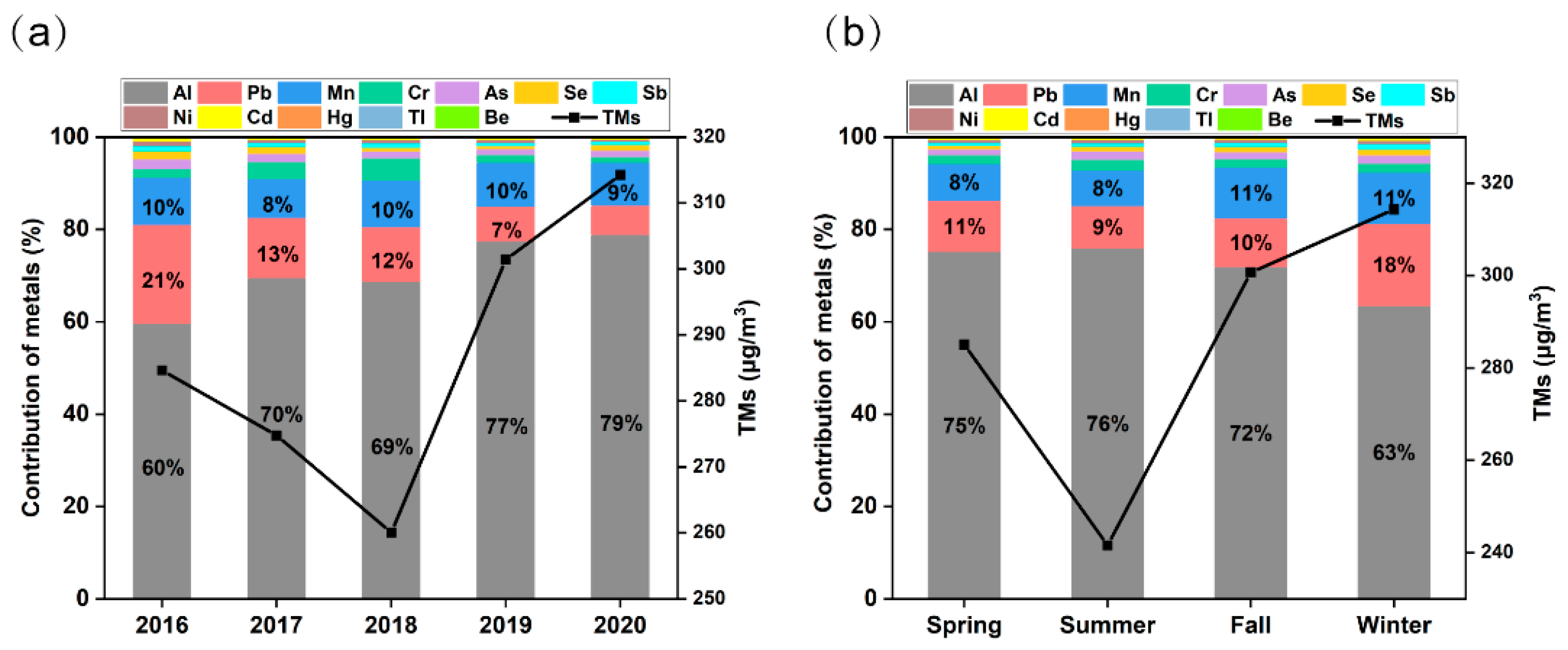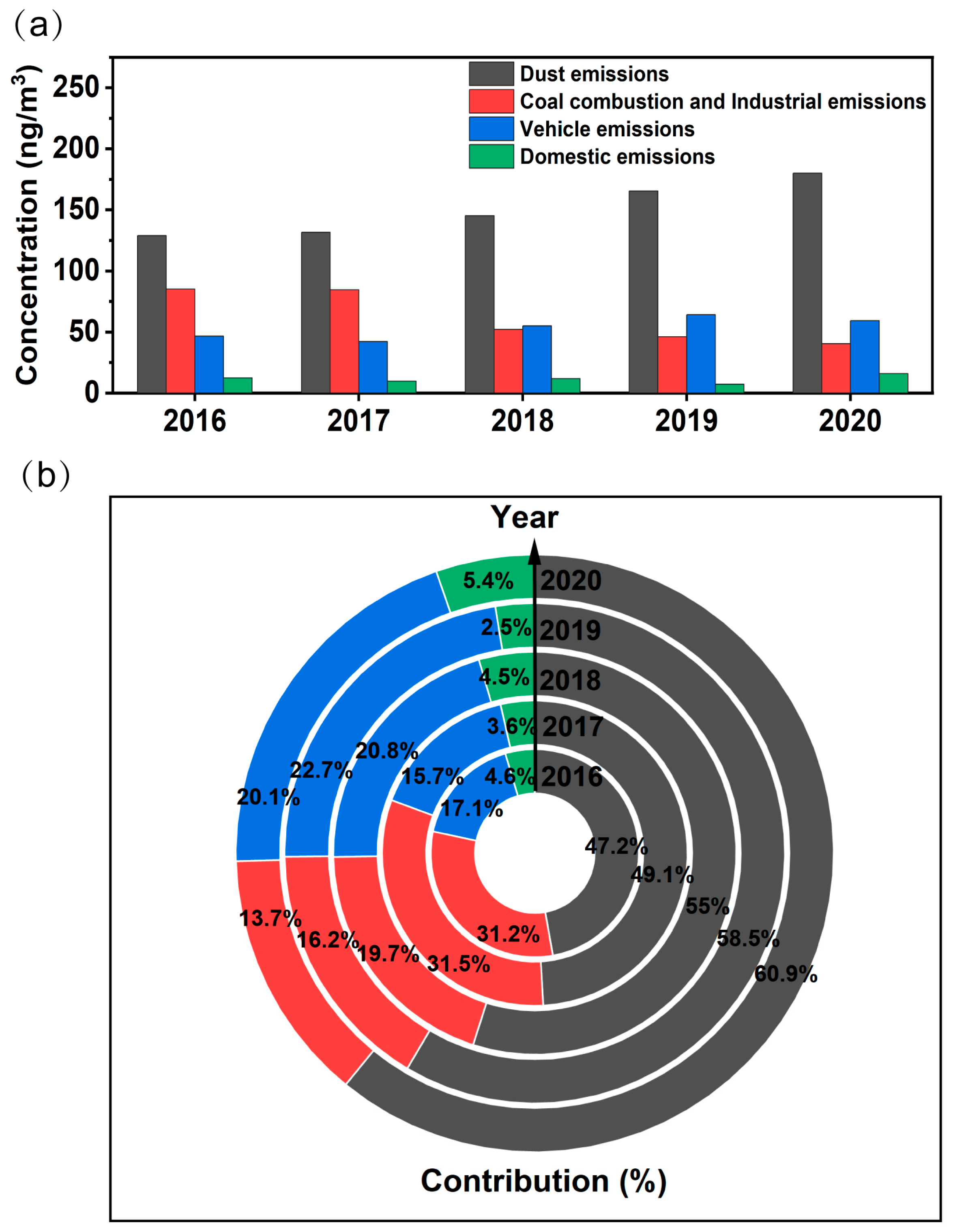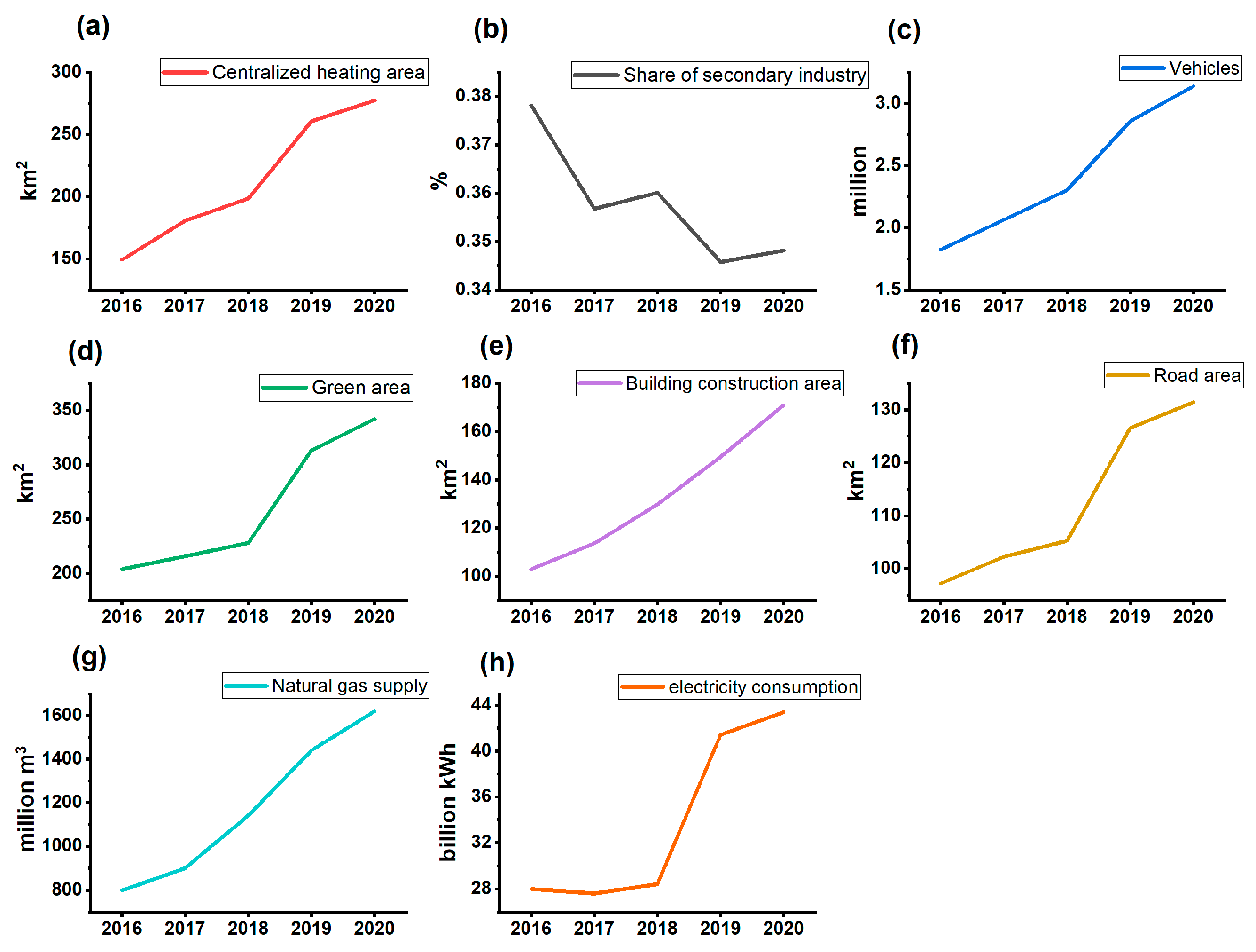Sources and Specified Health Risks of 12 PM2.5-Bound Metals in a Typical Air-Polluted City in Northern China during the 13th Five-Year Plan
Abstract
1. Introduction
2. Materials and Methods
2.1. Sampling Sites and Methods
2.2. Sample Treatment
2.3. Positive Matrix Factorization (PMF) Model
2.4. Health Risk Assessment
2.5. RM-RA Model
3. Results and Discussion
3.1. Long-Term Concentration Trends in PM2.5-Bound Metals
3.2. Characterization of Emission Sources of PM2.5-Bound Metals
3.2.1. Emission Sources Apportioned by PMF Model
3.2.2. Annual Trends in Sources: Concentrations and Contributions
3.3. Health Risk Assessment
3.3.1. Non-Carcinogenic and Carcinogenic Risks of Metals of Concern: Mn, As, and Cr
3.3.2. Source-Specific Health Risk Apportion Based on the RM-RA Model
3.4. Policy Implications
4. Conclusions
Supplementary Materials
Author Contributions
Funding
Institutional Review Board Statement
Informed Consent Statement
Data Availability Statement
Conflicts of Interest
References
- Liu, H.; Zhang, X.; Sun, Z.; Chen, Y. Ambient Fine Particulate Matter and Cancer: Current Evidence and Future Perspectives. Chem. Res. Toxicol. 2023, 36, 141–156. [Google Scholar] [CrossRef]
- Yue, H.; He, C.; Huang, Q.; Yin, D.; Bryan, B.A. Stronger Policy Required to Substantially Reduce Deaths from PM2.5 Pollution in China. Nat. Commun. 2020, 11, 1462. [Google Scholar] [CrossRef] [PubMed]
- Southerland, V.A.; Brauer, M.; Mohegh, A.; Hammer, M.S.; van Donkelaar, A.; Martin, R.V.; Apte, J.S.; Anenberg, S.C. Global Urban Temporal Trends in Fine Particulate Matter (PM2.5) and Attributable Health Burdens: Estimates from Global Datasets. Lancet Planet. Health 2022, 6, e139–e146. [Google Scholar] [CrossRef]
- Liu, T.; Jiang, B.; Fu, B.; Shang, C.; Feng, H.; Chen, T.; Jiang, Y. PM2.5 Induces Cardiomyoblast Senescence via AhR-Mediated Oxidative Stress. Antioxidants 2024, 13, 786. [Google Scholar] [CrossRef] [PubMed]
- Cristaldi, A.; Oliveri Conti, G.; Pellitteri, R.; La Cognata, V.; Copat, C.; Pulvirenti, E.; Grasso, A.; Fiore, M.; Cavallaro, S.; Dell’Albani, P.; et al. In Vitro Exposure to PM2.5 of Olfactory Ensheathing Cells and SH-SY5Y Cells and Possible Association with Neurodegenerative Processes. Environ. Res. 2024, 241, 117575. [Google Scholar] [CrossRef] [PubMed]
- Kazensky, L.; Matković, K.; Gerić, M.; Žegura, B.; Pehnec, G.; Gajski, G. Impact of Indoor Air Pollution on DNA Damage and Chromosome Stability: A Systematic Review. Arch. Toxicol. 2024; in press. [Google Scholar] [CrossRef]
- Hou, T.; Zhu, L.; Wang, Y.; Peng, L. Oxidative Stress Is the Pivot for PM2.5-Induced Lung Injury. Food Chem. Toxicol. 2024, 184, 114362. [Google Scholar] [CrossRef] [PubMed]
- Jyothi, N. Heavy Metal Sources and Their Effects on Human Health; IntechOpen: Loundon, UK, 2020. [Google Scholar] [CrossRef]
- Ghosh, B.; Padhy, P.K.; Niyogi, S.; Patra, P.K.; Hecker, M. A Comparative Study of Heavy Metal Pollution in Ambient Air and the Health Risks Assessment in Industrial, Urban and Semi-Urban Areas of West Bengal, India: An Evaluation of Carcinogenic, Non-Carcinogenic, and Additional Lifetime Cancer Cases. Environments 2023, 10, 190. [Google Scholar] [CrossRef]
- Potter, N.A.; Meltzer, G.Y.; Avenbuan, O.N.; Raja, A.; Zelikoff, J.T. Particulate Matter and Associated Metals: A Link with Neurotoxicity and Mental Health. Atmosphere 2021, 12, 425. [Google Scholar] [CrossRef]
- Niu, J.; Liberda, E.N.; Qu, S.; Guo, X.; Li, X.; Zhang, J.; Meng, J.; Yan, B.; Li, N.; Zhong, M.; et al. The Role of Metal Components in the Cardiovascular Effects of PM2.5. PLoS ONE 2013, 8, e83782. [Google Scholar] [CrossRef]
- Huang, B.; Chang, Y.; Han, A.; Hsu, H. Metal Composition of Ambient PM2.5 Influences the Pulmonary Function of Schoolchildren: A Case Study of School Located Nearby of an Electric Arc Furnace Factory. Toxicol. Ind. Health 2018, 34, 253–261. [Google Scholar] [CrossRef]
- Kurt-Karakus, P.B. Determination of Heavy Metals in Indoor Dust from Istanbul, Turkey: Estimation of the Health Risk. Environ. Int. 2012, 50, 47–55. [Google Scholar] [CrossRef] [PubMed]
- Viegas, S.; Ladeira, C.; Costa-Veiga, A.; Perelman, J.; Gajski, G. Forgotten Public Health Impacts of Cancer-an Overview. Arh. Hig. Rada Toksikol. 2017, 68, 287–297. [Google Scholar] [CrossRef] [PubMed]
- Nie, W.; Tao, W.; Ding, A.; Zhou, X.; Wang, W. A 14-Year Measurement of Toxic Elements in Atmospheric Particulates in Hong Kong from 1995 to 2008. Front. Environ. Sci. Eng. 2014, 8, 553–560. [Google Scholar] [CrossRef]
- Jiang, N.; Liu, X.; Wang, S.; Yu, X.; Yin, S.; Duan, S.; Wang, S.; Zhang, R.; Li, S. Pollution Characterization, Source Identification, and Health Risks of Atmospheric-Particle-Bound Heavy Metals in PM10 and PM2.5 at Multiple Sites in an Emerging Megacity in the Central Region of China. Aerosol Air Qual. Res. 2019, 19, 247–271. [Google Scholar] [CrossRef]
- Bai, W.; Zhao, X.; Yin, B.; Guo, L.; Zhang, W.; Wang, X.; Yang, W. Characteristics of PM2.5 in an Industrial City of Northern China: Mass Concentrations, Chemical Composition, Source Apportionment, and Health Risk Assessment. Int. J. Environ. Res. Public Health 2022, 19, 5443. [Google Scholar] [CrossRef] [PubMed]
- Ledoux, F.; Kfoury, A.; Delmaire, G.; Roussel, G.; El Zein, A.; Courcot, D. Contributions of Local and Regional Anthropogenic Sources of Metals in PM2.5 at an Urban Site in Northern France. Chemosphere 2017, 181, 713–724. [Google Scholar] [CrossRef]
- Liu, Z.; Zhan, C.; Liu, H.; Liu, S.; Quan, J.; Liu, X.; Zhang, J.; Qu, C. Source-Specific Health Risk of PM2.5-Bound Metals in a Typical Industrial City, Central China, 2021–2022. Atmosphere 2023, 14, 1406. [Google Scholar] [CrossRef]
- Oliveri Conti, G.; Heibati, B.; Kloog, I.; Fiore, M.; Ferrante, M. A Review of AirQ Models and Their Applications for Forecasting the Air Pollution Health Outcomes. Environ. Sci. Pollut. Res. 2017, 24, 6426–6445. [Google Scholar] [CrossRef] [PubMed]
- Kim, B.M.; Henry, R.C. Diagnostics for Determining Influential Species in the Chemical Mass Balance Receptor Model. J. Air Waste Manag. Assoc. 1999, 49, 1449–1455. [Google Scholar] [CrossRef]
- Thurston, G.D.; Spengler, J.D. A Quantitative Assessment of Source Contributions to Inhalable Particulate Matter Pollution in Metropolitan Boston. Atmos. Environ. (1967) 1985, 19, 9–25. [Google Scholar] [CrossRef]
- Paatero, P.; Tapper, U. Analysis of Different Modes of Factor Analysis as Least Squares Fit Problems. Chemom. Intell. Lab. Syst. 1993, 18, 183–194. [Google Scholar] [CrossRef]
- Jain, S.; Sharma, S.K.; Vijayan, N.; Mandal, T.K. Seasonal Characteristics of Aerosols (PM2.5 and PM10) and Their Source Apportionment Using PMF: A Four Year Study over Delhi, India. Environ. Pollut. 2020, 262, 114337. [Google Scholar] [CrossRef]
- Milando, C.; Huang, L.; Batterman, S. Trends in PM2.5 Emissions, Concentrations and Apportionments in Detroit and Chicago. Atmos. Environ. 2016, 129, 197–209. [Google Scholar] [CrossRef] [PubMed]
- Cheng, S.; Yang, L.; Zhou, X.; Wang, Z.; Zhou, Y.; Gao, X.; Nie, W.; Wang, X.; Xu, P.; Wang, W. Evaluating PM2.5 Ionic Components and Source Apportionment in Jinan, China from 2004 to 2008 Using Trajectory Statistical Methods. J. Environ. Monit. 2011, 13, 1662–1671. [Google Scholar] [CrossRef] [PubMed]
- Li, R.; Wang, J.; Xue, K.; Fang, C. Spatial and Temporal Distribution Characteristics and Influencing Factors Analysis of Particulate Matter Pollution in Jinan City. Air Qual. Atmos. Health 2021, 14, 1267–1278. [Google Scholar] [CrossRef]
- Yin, X.; Fan, G.; Liu, J.; Jiang, T.; Wang, L. Characteristics of Heavy Metals and Persistent Organic Pollutants in PM2.5 in Two Typical Industrial Cities, North China. Environ. Forensics 2020, 21, 250–258. [Google Scholar] [CrossRef]
- Weidong, G.; Wei, J.; Xiaomei, G.; Mimi, Z. The Analysis on Air Pollution Characteristics at the Bus Stops in Jinan City. IOP Conf. Ser. Earth Environ. Sci. 2019, 295, 012002. [Google Scholar] [CrossRef]
- Guo, J.; Wang, H.; Liu, S.; Wang, Z. Chemical Characteristics and Source Apportionment of PM2.5 in Western Industrial Region of Jinan. Atmosphere 2023, 14, 864. [Google Scholar] [CrossRef]
- Paatero, P.; Tapper, U. Positive Matrix Factorization: A Non-negative Factor Model with Optimal Utilization of Error Estimates of Data Values. Environmetrics 1994, 5, 111–126. [Google Scholar] [CrossRef]
- Lucarelli, F.; Calzolai, G.; Chiari, M.; Giardi, F.; Czelusniak, C.; Nava, S. Hourly Elemental Composition and Source Identification by Positive Matrix Factorization (PMF) of Fine and Coarse Particulate Matter in the High Polluted Industrial Area of Taranto (Italy). Atmosphere 2020, 11, 419. [Google Scholar] [CrossRef]
- López, M.L.; Ceppi, S.; Palancar, G.G.; Olcese, L.E.; Tirao, G.; Toselli, B.M. Elemental Concentration and Source Identification of PM10 and PM2.5 by SR-XRF in Córdoba City, Argentina. Atmos. Environ. 2011, 45, 5450–5457. [Google Scholar] [CrossRef]
- Gao, Y.; Guo, X.; Li, C.; Ding, H.; Tang, L.; Ji, H. Characteristics of PM2.5 in Miyun, the Northeastern Suburb of Beijing: Chemical Composition and Evaluation of Health Risk. Environ. Sci. Pollut. Res. Int. 2015, 22, 16688–16699. [Google Scholar] [CrossRef] [PubMed]
- Gholizadeh, A.; Taghavi, M.; Moslem, A.; Neshat, A.A.; Lari Najafi, M.; Alahabadi, A.; Ahmadi, E.; Ebrahimi aval, H.; Asour, A.A.; Rezaei, H.; et al. Ecological and Health Risk Assessment of Exposure to Atmospheric Heavy Metals. Ecotoxicol. Environ. Saf. 2019, 184, 109622. [Google Scholar] [CrossRef] [PubMed]
- Huang, R.; Cheng, R.; Jing, M.; Yang, L.; Li, Y.; Chen, Q.; Chen, Y.; Yan, J.; Lin, C.; Wu, Y.; et al. Source-Specific Health Risk Analysis on Particulate Trace Elements: Coal Combustion and Traffic Emission As Major Contributors in Wintertime Beijing. Environ. Sci. Technol. 2018, 52, 10967–10974. [Google Scholar] [CrossRef] [PubMed]
- Moya, J.; Phillips, L. Overview of the Use of the U.S. EPA Exposure Factors Handbook. Int. J. Hyg. Environ. Health 2002, 205, 155–159. [Google Scholar] [CrossRef] [PubMed][Green Version]
- Cable, E.; Deng, Y. Trace Elements in Atmospheric Wet Precipitation in the Detroit Metropolitan Area: Levels and Possible Sources. Chemosphere 2018, 210, 1091–1098. [Google Scholar] [CrossRef] [PubMed]
- Shen, C.D.; Yi, W.X.; Ding, P.; Liu, K.X.; Xu, X.M. 14C and 10Be in Dust Deposited During the Storm of 16–17 April 2006 in Beijing. Radiocarbon 2013, 55, 1790–1800. [Google Scholar] [CrossRef]
- Yang, Q.; Yuan, Q.; Li, T.; Shen, H.; Zhang, L. The Relationships between PM2.5 and Meteorological Factors in China: Seasonal and Regional Variations. Int. J. Environ. Res. Public. Health 2017, 14, 1510. [Google Scholar] [CrossRef] [PubMed]
- Huang, F.; Li, X.; Wang, C.; Xu, Q.; Wang, W.; Luo, Y.; Tao, L.; Gao, Q.; Guo, J.; Chen, S.; et al. PM2.5 Spatiotemporal Variations and the Relationship with Meteorological Factors during 2013-2014 in Beijing, China. PLoS ONE 2015, 10, e0141642. [Google Scholar] [CrossRef]
- The Impacts of the Meteorology Features on PM2.5 Levels during a Severe Haze Episode in Central-East China. Atmos. Environ. 2019, 197, 177–189. [CrossRef]
- Guo, Q.; He, Z.; Wang, Z. Change in Air Quality during 2014–2021 in Jinan City in China and Its Influencing Factors. Toxics 2023, 11, 210. [Google Scholar] [CrossRef] [PubMed]
- Khan, M.F.; Latif, M.T.; Saw, W.H.; Amil, N.; Nadzir, M.S.M.; Sahani, M.; Tahir, N.M.; Chung, J.X. Fine Particulate Matter in the Tropical Environment: Monsoonal Effects, Source Apportionment, and Health Risk Assessment. Atmos. Chem. Phys. 2016, 16, 597–617. [Google Scholar] [CrossRef]
- Moreira, T.C.; de Oliveira, R.C.; Amato, L.F.; Kang, C.M.; Saldiva, P.H.; Saiki, M. Intra-Urban Biomonitoring: Source Apportionment Using Tree Barks to Identify Air Pollution Sources. Environ. Int. 2016, 91, 271–275. [Google Scholar] [CrossRef] [PubMed]
- Coufalík, P.; Matoušek, T.; Křůmal, K.; Vojtíšek-Lom, M.; Beránek, V.; Mikuška, P. Content of Metals in Emissions from Gasoline, Diesel, and Alternative Mixed Biofuels. Environ. Sci. Pollut. Res. 2019, 26, 29012–29019. [Google Scholar] [CrossRef]
- Hsu, C.; Chi, K.; Wu, C.; Lin, S.; Hsu, W.; Tseng, C.; Chen, M.; Chen, Y. Integrated Analysis of Source-Specific Risks for PM2.5-Bound Metals in Urban, Suburban, Rural, and Industrial Areas. Environ. Pollut. 2021, 275, 116652. [Google Scholar] [CrossRef] [PubMed]
- Tian, H.; Zhao, D.; Cheng, K.; Lu, L.; He, M.; Hao, J. Anthropogenic Atmospheric Emissions of Antimony and Its Spatial Distribution Characteristics in China. Environ. Sci. Technol. 2012, 46, 3973–3980. [Google Scholar] [CrossRef]
- Petaloti, C.; Triantafyllou, A.; Kouimtzis, T.; Samara, C. Trace Elements in Atmospheric Particulate Matter over a Coal Burning Power Production Area of Western Macedonia, Greece. Chemosphere 2006, 65, 2233–2243. [Google Scholar] [CrossRef] [PubMed]
- Bolan, S.; Wijesekara, H.; Tanveer, M.; Boschi, V.; Padhye, L.P.; Wijesooriya, M.; Wang, L.; Jasemizad, T.; Wang, C.; Zhang, T.; et al. Beryllium Contamination and Its Risk Management in Terrestrial and Aquatic Environmental Settings. Environ. Pollut. 2023, 320, 121077. [Google Scholar] [CrossRef]
- Liu, B.; Li, T.; Yang, J.; Wu, J.; Wang, J.; Gao, J.; Bi, X.; Feng, Y.; Zhang, Y.; Yang, H. Source Apportionment and a Novel Approach of Estimating Regional Contributions to Ambient PM2.5 in Haikou, China. Environ. Pollut. 2017, 223, 334–345. [Google Scholar] [CrossRef]
- Zou, B.; Huang, X.; Zhang, B.; Dai, J.; Zeng, L.; Feng, N.; He, L. Source Apportionment of PM2.5 Pollution in an Industrial City in Southern China. Atmos. Pollut. Res. 2017, 8, 1193–1202. [Google Scholar] [CrossRef]
- Zhou, Q.; Zheng, N.; Liu, J.; Wang, Y.; Sun, C.; Liu, Q.; Wang, H.; Zhang, J. Residents Health Risk of Pb, Cd and Cu Exposure to Street Dust Based on Different Particle Sizes around Zinc Smelting Plant, Northeast of China. Environ. Geochem. Health 2015, 37, 207–220. [Google Scholar] [CrossRef] [PubMed]
- Zhong, C.; Yang, Z.; Jiang, W.; Hu, B.; Hou, Q.; Yu, T.; Li, J. Ecological Geochemical Assessment and Source Identification of Trace Elements in Atmospheric Deposition of an Emerging Industrial Area: Beibu Gulf Economic Zone. Sci. Total Environ. 2016, 573, 1519–1526. [Google Scholar] [CrossRef] [PubMed]
- Duan, J.; Tan, J.; Wang, S.; Hao, J.; Chai, F. Size Distributions and Sources of Elements in Particulate Matter at Curbside, Urban and Rural Sites in Beijing. J. Environ. Sci. 2012, 24, 87–94. [Google Scholar] [CrossRef] [PubMed]
- Deonarine, A.; Schwartz, G.E.; Ruhl, L.S. Environmental Impacts of Coal Combustion Residuals: Current Understanding and Future Perspectives. Environ. Sci. Technol. 2023, 57, 1855–1869. [Google Scholar] [CrossRef] [PubMed]
- Li, C.; Bai, L.; Qin, J.; Guo, Y.; Wang, H.; Xu, X. Study on Metal Elements in Indoor Particulate Matter: A Case Study of Rural Residential Environment in Northeast China. Environ. Geochem. Health 2023, 45, 4867–4881. [Google Scholar] [CrossRef] [PubMed]
- Schleicher, N.J.; Weiss, D.J. Identification of Atmospheric Particulate Matter Derived from Coal and Biomass Burning and from Non-Exhaust Traffic Emissions Using Zinc Isotope Signatures. Environ. Pollut. 2023, 329, 121664. [Google Scholar] [CrossRef]
- Yan, R.-H.; Peng, X.; Lin, W.; He, L.-Y.; Wei, F.-H.; Tang, M.-X.; Huang, X.-F. Trends and Challenges Regarding the Source-Specific Health Risk of PM2.5-Bound Metals in a Chinese Megacity from 2014 to 2020. Environ. Sci. Technol. 2022, 56, 6996–7005. [Google Scholar] [CrossRef] [PubMed]
- Yan, H.; Ding, G.; Li, H.; Wang, Y.; Zhang, L.; Shen, Q.; Feng, K. Field Evaluation of the Dust Impacts from Construction Sites on Surrounding Areas: A City Case Study in China. Sustainability 2019, 11, 1906. [Google Scholar] [CrossRef]
- Yao, X.; Steven Xu, X.; Yang, Y.; Zhu, Z.; Zhu, Z.; Tao, F.; Yuan, M. Stratification of Population in NHANES 2009-2014 Based on Exposure Pattern of Lead, Cadmium, Mercury, and Arsenic and Their Association with Cardiovascular, Renal and Respiratory Outcomes. Environ. Int. 2021, 149, 106410. [Google Scholar] [CrossRef]
- Fu, S.; Yue, D.; Lin, W.; Hu, Q.; Yuan, L.; Zhao, Y.; Zhai, Y.; Mai, D.; Zhang, H.; Wei, Q.; et al. Insights into the Source-Specific Health Risk of Ambient Particle-Bound Metals in the Pearl River Delta Region, China. Ecotoxicol. Environ. Saf. 2021, 224, 112642. [Google Scholar] [CrossRef]
- Xie, J.; Jin, L.D.; Cui, J.D.; Luo, X.D.; Li, J.D.; Zhang, G.D.; Li, X.P. Health Risk-Oriented Source Apportionment of PM2.5-Associated Trace Metals. Environ. Pollut. 2020, 262, 114655. [Google Scholar] [CrossRef] [PubMed]
- Sui, S.; Ng, J.; Gao, Y.; Peng, C.; He, C.; Wang, G.; Liu, Z. Pollution Characteristics and Chronic Health Risk Assessment of Metals and Metalloids in Ambient PM2.5 in Licheng District, Jinan, China. Environ. Geochem. Health 2020, 42, 1803–1815. [Google Scholar] [CrossRef]
- Motesaddi Zarandi, S.; Shahsavani, A.; Khodagholi, F.; Fakhri, Y. Concentration, Sources and Human Health Risk of Heavy Metals and Polycyclic Aromatic Hydrocarbons Bound PM2.5 Ambient Air, Tehran, Iran. Environ. Geochem. Health 2019, 41, 1473–1487. [Google Scholar] [CrossRef]
- Zhai, Y.; Liu, X.; Chen, H.; Xu, B.; Zhu, L.; Li, C.; Zeng, G. Source Identification and Potential Ecological Risk Assessment of Heavy Metals in PM2.5 from Changsha. Sci. Total Environ. 2014, 493, 109–115. [Google Scholar] [CrossRef] [PubMed]
- Zhuo, H.; Fu, S.; Liu, H.; Song, H.; Ren, L. Soil Heavy Metal Contamination and Health Risk Assessment Associated with Development Zones in Shandong, China. Environ. Sci. Pollut. Res. Int. 2019, 26, 30016–30028. [Google Scholar] [CrossRef]
- Tan, Z.; Li, X.; Gao, M.; Jiang, L. The Environmental Story During the COVID-19 Lockdown: How Human Activities Affect PM2.5 Concentration in China? IEEE Geosci. Remote Sens. Lett. 2022, 19, 1001005. [Google Scholar] [CrossRef]
- Manchanda, C.; Kumar, M.; Singh, V.; Faisal, M.; Hazarika, N.; Shukla, A.; Lalchandani, V.; Goel, V.; Thamban, N.; Ganguly, D.; et al. Variation in Chemical Composition and Sources of PM2.5 during the COVID-19 Lockdown in Delhi. Environ. Int. 2021, 153, 106541. [Google Scholar] [CrossRef]
- Zhang, X.; Fung, J.C.H.; Zhang, Y.; Lau, A.K.H.; Leung, K.K.M.; Huang, W. Assessing PM2.5 Emissions in 2020: The Impacts of Integrated Emission Control Policies in China. Environ. Pollut. 2020, 263, 114575. [Google Scholar] [CrossRef]
- Hjortenkrans, D.S.T.; Bergbäck, B.G.; Häggerud, A.V. Metal Emissions from Brake Linings and Tires: Case Studies of Stockholm, Sweden 1995/1998 and 2005. Environ. Sci. Technol. 2007, 41, 5224–5230. [Google Scholar] [CrossRef] [PubMed]
- Adamiec, E.; Jarosz-Krzemińska, E.; Wieszała, R. Heavy Metals from Non-Exhaust Vehicle Emissions in Urban and Motorway Road Dusts. Environ. Monit. Assess. 2016, 188, 369. [Google Scholar] [CrossRef]
- Liu, S.; Tian, H.; Bai, X.; Zhu, C.; Wu, B.; Luo, L.; Hao, Y.; Liu, W.; Lin, S.; Zhao, S.; et al. Significant but Spatiotemporal-Heterogeneous Health Risks Caused by Airborne Exposure to Multiple Toxic Trace Elements in China. Environ. Sci. Technol. 2021, 55, 12818–12830. [Google Scholar] [CrossRef] [PubMed]
- Fu, Z.; Wu, Y.; Zhao, S.; Bai, X.; Liu, S.; Zhao, H.; Hao, Y.; Tian, H. Emissions of Multiple Metals from Vehicular Brake Linings Wear in China, 1980–2020. Sci. Total Environ. 2023, 889, 164380. [Google Scholar] [CrossRef] [PubMed]
- Sun, C.; Xu, S.; Yang, M.; Gong, X. Urban Traffic Regulation and Air Pollution: A Case Study of Urban Motor Vehicle Restriction Policy. Energy Policy 2022, 163, 112819. [Google Scholar] [CrossRef]
- Dai, S.; Bi, X.; Chan, L.Y.; He, J.; Wang, B.; Wang, X.; Peng, P.; Sheng, G.; Fu, J. Chemical and Stable Carbon Isotopic Composition of PM2.5 from on-Road Vehicle Emissions in the PRD Region and Implications for Vehicle Emission Control Policy. Atmos. Chem. Phys. 2015, 15, 3097–3108. [Google Scholar] [CrossRef]
- Liu, J.; Chen, H.; Qiao, S.; Zhang, Y. Indoor/Outdoor Relationships of PM2.5-Associated Toxic Metals/Metalloids at a Rural Residence in North China: Sources and Probabilistic Health Risks. Atmos. Pollut. Res. 2023, 14, 101753. [Google Scholar] [CrossRef]
- Wang, B.; Cao, S.; Zhao, X.; Dong, T.; Nie, J.; Duan, X. Time-Activity Factors Related to Air Exposure. In Highlights of the Chinese Exposure Factors Handbook; Duan, X., Zhao, X., Wang, B., Chen, Y., Cao, S., Eds.; Academic Press: Beijing, China, 2015; pp. 31–39. ISBN 978-0-12-803125-4. [Google Scholar]
- The Provisional Peer Reviewed Toxicity Values [DB/OL]. 2017. Available online: https://hhpprtv.ornl.gov/quickview/pprtv.php (accessed on 5 August 2024).
- IRIS. IRIS Advanced Search [DB/OL]. 2017. Available online: https://cfpub.epa.gov/ncea/iris2/atoz.cfm (accessed on 5 August 2024).
- CALEPA. OEHHA Chemical Database—Air [DB/OL]. 2017. Available online: https://oehha.ca.gov/air/chemicals (accessed on 5 August 2024).
- Minimal Risk Levels for Hazardous Substances (MRLs) [DB/OL]. 2017. Available online: https://www.atsdr.cdc.gov/mrls/mrllist.asp#39tag (accessed on 5 August 2024).






Disclaimer/Publisher’s Note: The statements, opinions and data contained in all publications are solely those of the individual author(s) and contributor(s) and not of MDPI and/or the editor(s). MDPI and/or the editor(s) disclaim responsibility for any injury to people or property resulting from any ideas, methods, instructions or products referred to in the content. |
© 2024 by the authors. Licensee MDPI, Basel, Switzerland. This article is an open access article distributed under the terms and conditions of the Creative Commons Attribution (CC BY) license (https://creativecommons.org/licenses/by/4.0/).
Share and Cite
Yang, D.; Li, M.; Geng, X.; Feng, Z. Sources and Specified Health Risks of 12 PM2.5-Bound Metals in a Typical Air-Polluted City in Northern China during the 13th Five-Year Plan. Toxics 2024, 12, 581. https://doi.org/10.3390/toxics12080581
Yang D, Li M, Geng X, Feng Z. Sources and Specified Health Risks of 12 PM2.5-Bound Metals in a Typical Air-Polluted City in Northern China during the 13th Five-Year Plan. Toxics. 2024; 12(8):581. https://doi.org/10.3390/toxics12080581
Chicago/Turabian StyleYang, Deai, Mingjun Li, Xingyi Geng, and Zhihui Feng. 2024. "Sources and Specified Health Risks of 12 PM2.5-Bound Metals in a Typical Air-Polluted City in Northern China during the 13th Five-Year Plan" Toxics 12, no. 8: 581. https://doi.org/10.3390/toxics12080581
APA StyleYang, D., Li, M., Geng, X., & Feng, Z. (2024). Sources and Specified Health Risks of 12 PM2.5-Bound Metals in a Typical Air-Polluted City in Northern China during the 13th Five-Year Plan. Toxics, 12(8), 581. https://doi.org/10.3390/toxics12080581






